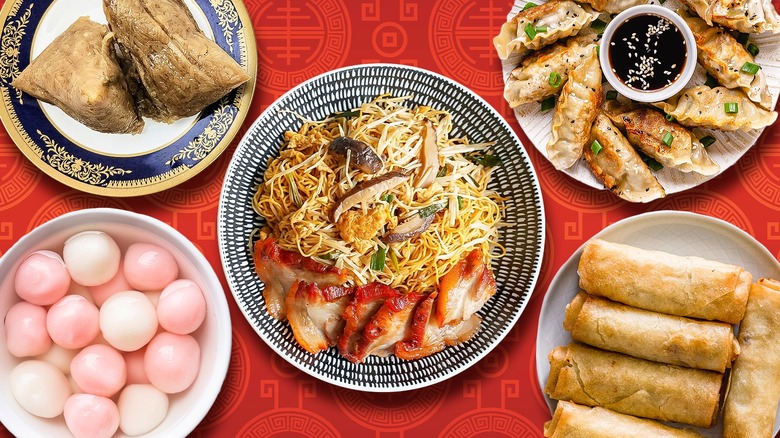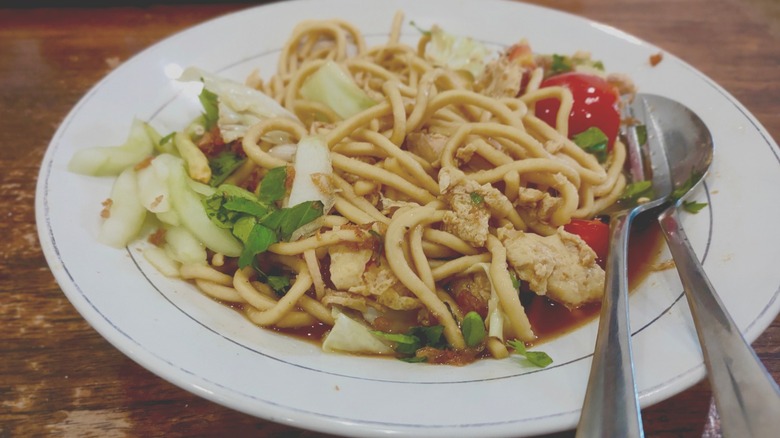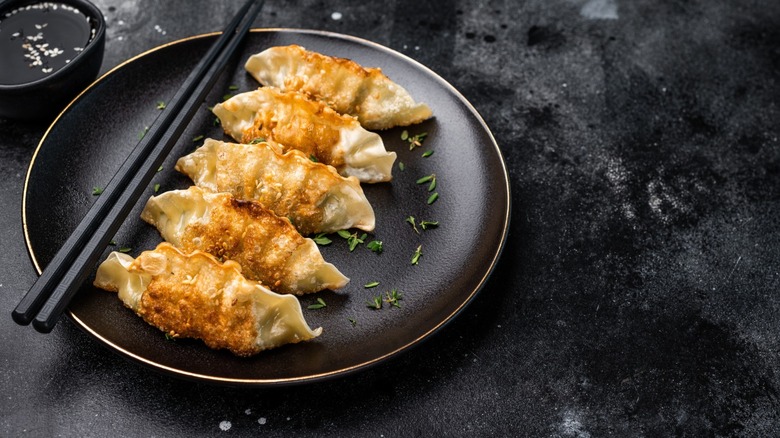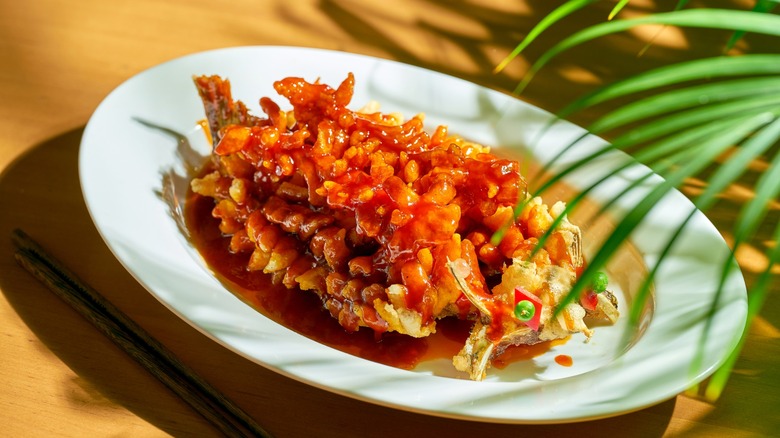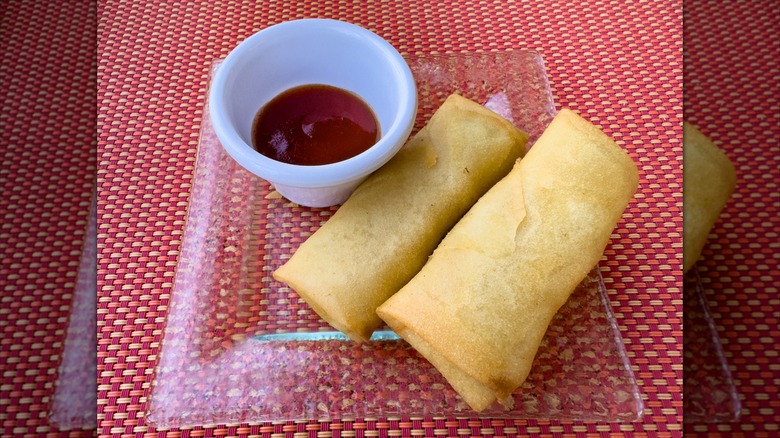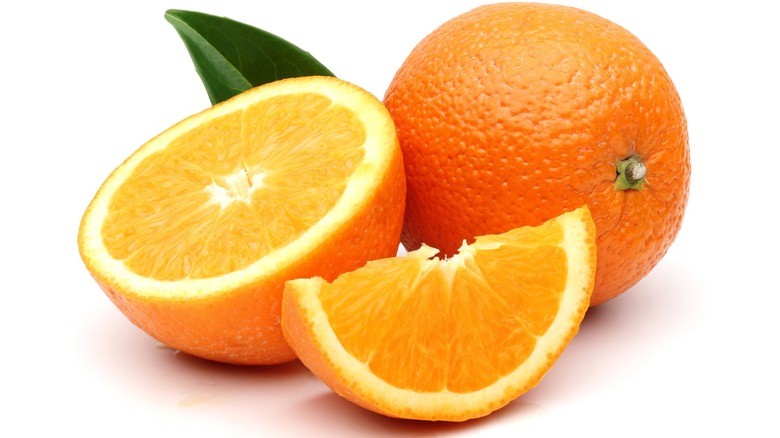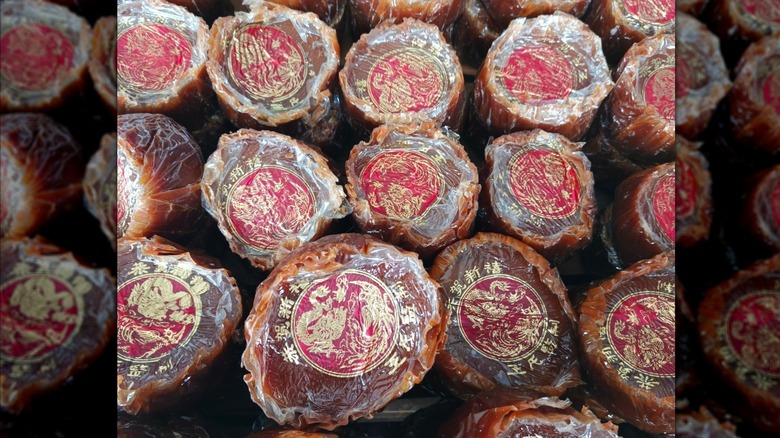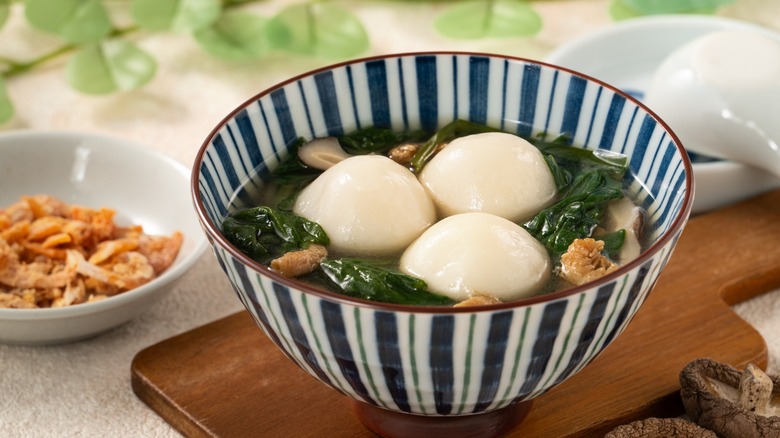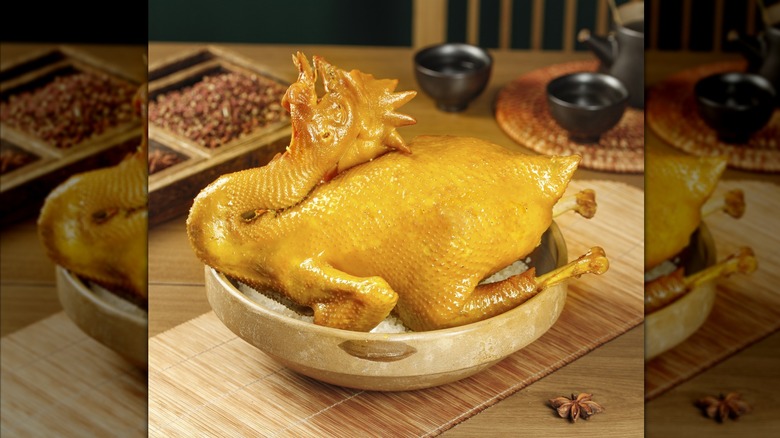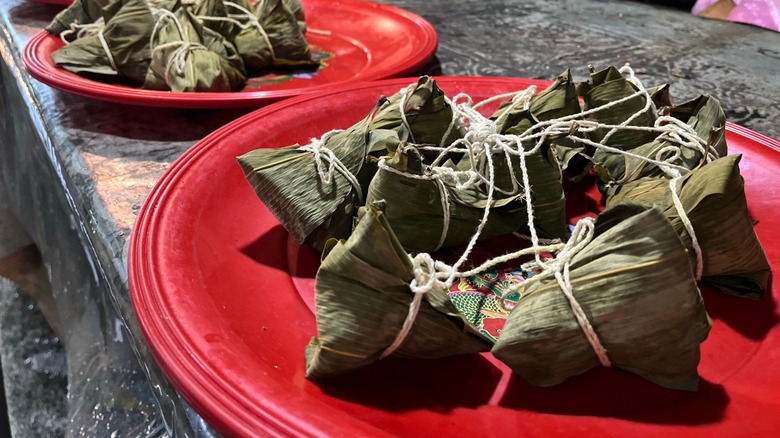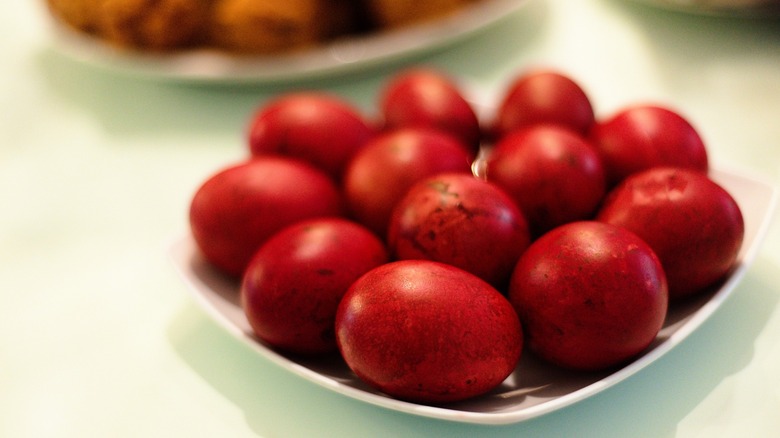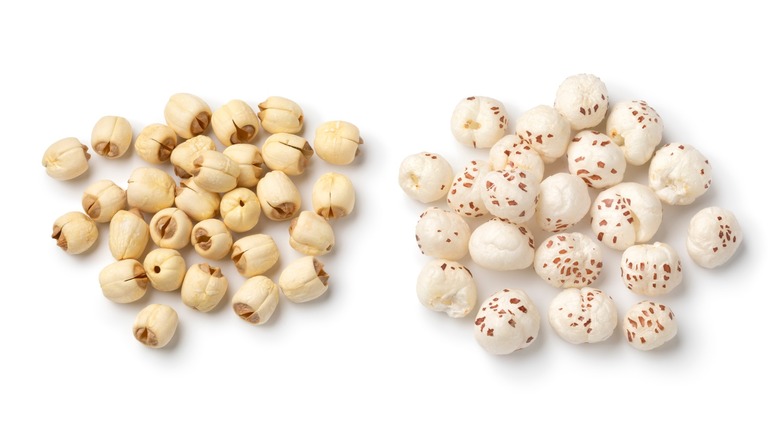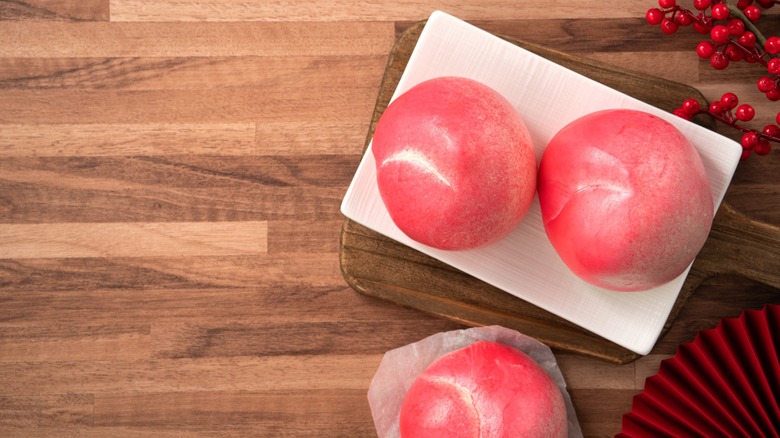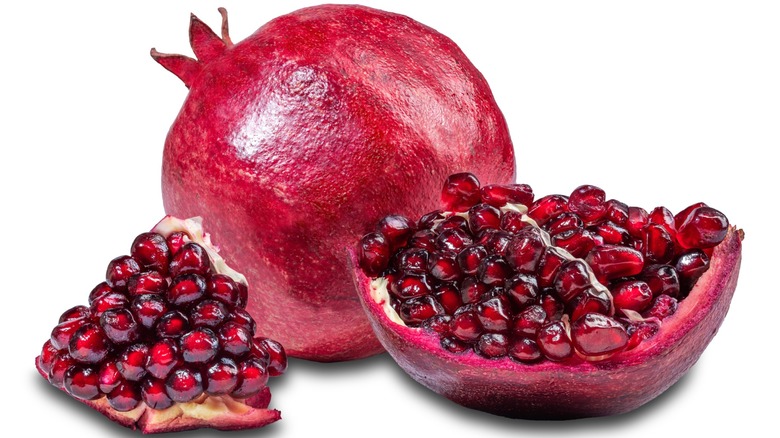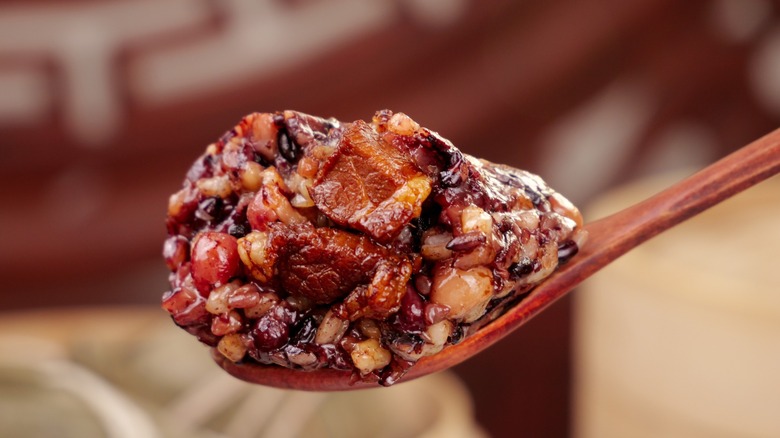14 Foods In Chinese Cuisine With Symbolic Meanings
Chinese food was the international cuisine Julia Child couldn't live without, and if that isn´t reason enough to love and respect it, the rich symbolism of delicious fare hailing from China definitely is. In Chinese culture, food has always been about far more than mere physical sustenance. One could look at it as a language in itself, one that tells a story, and one that utters hopes and wishes for (and even manifests) good things for the future to come. Every flavor, color, and texture carries deep meaning, weaving together the hopes, traditions, and blessings that have nourished Chinese individuals and families for thousands of years.
This strong and fervent belief that specific foods could invoke blessings or ward off misfortune naturally turned meals into traditional rituals of luck, love, and gratitude. The significance lies in myriad niches, stemming from the sound of a food's name, its particular shape, or even its color. Each possesses layers of meaning that transform everyday dishes into edible symbols of what is, and what is to come.
This explains why cooking in China goes beyond simple meal prep and ventures into true art territory, with each dish set on the table reflecting balance and harmony, and the symbiosis of elements found in nature that mean much more than their face value. The culinary process itself embodies the philosophy that food should nourish both body and soul, bringing peace and equilibrium to those who share it. From the fish that represents abundance to delicate desserts that express wishes for wonderful blessings to come, come explore the fascinating world of Chinese food symbolism, where every ingredient has a story, every dish carries a dream, and every bite is a blessing.
Longevity noodles
We have discussed before the fascinating fact behind why Chinese restaurants almost always have round tables, but many wonder what it is about super-long noodles (called longevity noodles) that Chinese culture seems so obsessed with. These remarkably long, uncut strands (often stir-fried or served in broth) are a birthday and festival staple in China, believed to bring the eater a long, healthy life. Chinese tradition insists that the noodles remain unbroken from pot to plate, as cutting them is said to symbolically shorten one's years.
This specific ritual is thought to date back to the Han Dynasty, where Emperor Wu, upon hearing that a "long face" meant a "long life" (and not having a particularly long face himself), cleverly decided to lengthen his years through long noodles instead. This choice seems bizarre until one understands that the word for "noodle" sounds similar to the word for "face" in China. Long (face) story short, the idea took hold and soon spread beyond the palace.
Today, these noodles can be found served across the globe, each unbroken strand carrying a wish that life will stretch on and on.
Jiaozi
Golden-crescent dumplings called jiaozi are the centerpiece of countless Lunar New Year feasts. Their curved shape mirrors the look of ancient Chinese gold ingots (ancient currency), so serving them is believed to invite prosperity. Families gather on New Year's Eve to wrap and fold the dumplings together, then boil or steam them to share when midnight arrives, along with wishes of wealth for the coming year.
According to legend, during the Eastern Han Dynasty, the physician Zhang Zhongjing created the first dumplings as practical medicine. He is said to have filled dough wrappers with lamb, herbs, and chili to warm villagers who had suffered frostbitten ears, shaping the dumplings like tiny ears. His invention both healed and nourished villagers, and the name jiao'er ( "tender ears" ) eventually evolved into what we now know as jiaozi.
What began as a humble remedy has become a festive dish linked with luck and kinship. Some households even tuck a coin inside one dumpling for a single fortunate diner to discover. Whether filled with pork, beef, or vegetables, jiaozi dumplings are like a bite-sized promise of prosperity that has endured since ancient kitchens first steamed with their intoxicating scents.
Whole fish (Yu)
In Chinese culture, fish is considered among the foods meant to bring you good luck in the New Year. But not just any fish — it must be a whole fish. In fact, serving a whole fish at Lunar New Year is one of China's most enduring culinary customs. Across the country, whether steamed, braised, or fried, a gleaming fish takes center stage on the holiday table. Its presence carries a layered blessing. The Chinese word "fish" sounds exactly like "surplus," turning the preparation of it for the New Year into a heartfelt toast for abundance in the coming season.
The fish is typically presented intact, and there is a pristine and strict etiquette that surrounds how exactly it's served, including even which direction the head faces and much more. Families often purchase the fish live, season it simply with ginger, scallions, and a touch of wine before steaming it to silky tenderness. Some finish it with a quick pour of sizzling oil for fragrance, though many prefer to keep the flavor light and pure.
Around tables across the world, as diners admire the platter, they echo the age-old blessing of complete abundance in all things.
Spring rolls
We have written about everything you need to know regarding Asian egg rolls, but Chinese spring rolls deserve their very own distinction. Crisp and golden, Chinese spring rolls are far more than a famous festival snack enjoyed during post-winter festivities. They are edible symbols of renewal and prosperity, and their name alone hints at their purpose. Eaten to welcome spring during the Spring Festival, their shiny cylindrical form resembles gold bars, making them a delicious metaphor for wealth and good fortune. As they sizzle in oil and turn a lustrous gold, each roll becomes a hopeful wish for abundance for the year ahead.
The story of spring rolls traces back to before the Tang Dynasty, when people made delicate pancakes (thin flour wraps filled with seasonal vegetables) as offerings at the beginning of spring. These evolved into the rolled and fried treats that are enjoyed today.
Now enjoyed worldwide, spring rolls still embody the optimism of the season at this special time of year. The Chinese versions are fried and flaky, not to be confused with Vietnamese ones that come wrapped in rice paper, but both do share a symbolic thread that is the celebration of new life, hope, and vigor.
Tangerines and oranges
As the Lunar New Year approaches, households across China fill bowls with tangerines and oranges (mandarin mostly, but all kinds are acceptable). These fruits aren't just for decoration and making things festive, but instead are actual manifestations of blessings in plain sight. The word for tangerine (kam in Cantonese) sounds like "gold," and the word for orange resembles the sound of "luck" or "success." So, displaying or gifting them during New Year celebrations is thought to draw wealth and fortune into the home.
Tradition holds that pairs of oranges are given to guests or exchanged between friends and families as tokens of good wishes. The bright color of the fruits symbolizes joy and energy, echoing the festive reds and golds synonymous with the season. It's common to see oranges and tangerines in markets and on altars, shining right beside symbolic flowers and sweets.
Whether displayed in a home or offered to neighbors or friends with both hands, these simple fruits express an open-hearted hope that the coming year will be as bright and sweet as the fruit itself.
Nián-gāo
Nián-gāo (the traditional Chinese New Year rice cake) carries one of the most uplifting wishes of the season. It bestows on its recipient a wish that they might rise higher with every passing year. The Chinese phrase nián gāo sounds like "year high," which explains the symbolism attached to it. Sharing or gifting this chewy delicacy is a way to bless others with advancement of some kind, be it in their career, with monetary wealth, or richness in their family life.
Legends swirl around its origins. One story tells of nián-gāo being offered to the Kitchen God at year's end, the sticky texture ensuring that he could only speak sweetly about the household when reporting to the Jade Emperor. Another tells of a general Wu Zixu, whose bricks made of glutinous rice flour saved the starving people after a city attack, later inspiring the rice cake as a symbol of resilience and remembrance.
Today, nián-gāo comes in countless shapes and flavors. Fish-shaped cakes suggest prosperity, while gold-bar forms echo wealth, and circular ones represent harmony and endless luck. However enjoyed, this humble cake remains a sweet embodiment of the fact that aspiration is a good thing, and with every new year, we can all rise a little higher.
Tangyuan / Yuanxiao
When the first full moon of the year glows during the Lantern Festival, families gather under soft lantern light to enjoy bowls of tangyuan or yuanxiao. These smooth, round rice balls represent unity and affection, and their shape echoes the moon itself, also a symbol of completeness and reunion. Eating them together is both a celebration and a wish that one's family bonds will remain whole, love will remain close, and fortune will circle back again and again.
The two treats differ slightly by region. In southern China, tangyuan are made by wrapping a soft filling (often sesame, peanut, or even savory meat) in glutinous rice dough. In the north, yuanxiao are formed by rolling the filling in rice flour until smooth. These delicate sweets have been eaten for centuries, marking the close of New Year festivities and the start of spring. Lanterns lighting up the night once even guided matchmaking couples, giving the festival a romantic air, kind of like a Chinese Valentine's Day.
Whether eaten in celebration or love, tangyuan and yuanxiao carry one universal message that happiness is found when hearts, like rice balls, stay whole.
Whole chicken
A whole chicken, glistening with golden skin and served with head and feet still intact, is one of the most meaningful dishes in Chinese celebrations, especially during the Lunar New Year. Beyond its rich aroma and tender meat, an entire chicken carries a deep message of wholeness, unity, and family harmony. Serving the bird whole, without separation, symbolizes the wish that the coming year, and the family itself, will remain intact and prosperous from beginning to end.
The Chinese word for chicken sounds like "auspicious," linking the dish to luck and success. During banquets, it's often referred to poetically as Zhanchi Gaofei, meaning "wings of success," signifying a hope that loved ones will "fly high," be it in their studies, their careers, or even their own personal growth.
Traditionally, the chicken is poached, braised, or salt-baked, and families also present a whole chicken as an offering to ancestors as a way of showing gratitude and inviting blessings for the year ahead. Whatever way you decide to prepare or enjoy it, an entire chicken on the table is not just good eating, but also a good omen for things to come.
Zongzi
Every year, during the Dragon Boat Festival, families across China prepare zongzi. These fragrant parcels of glutinous rice wrapped in bamboo leaves are deeply symbolic and far surpass the category of mere festive snack food. You could go so far as to say these sticky rice dumplings are a culinary act of remembrance, a symbol of love, and an omen of protection.
The custom of wrapping zongzi dates back to the legend of Qu Yuan, a poet who drowned himself in the river. Distraught villagers, in order to protect his body from being eaten by the fish, threw rice into the water to distract them. This impromptu offering evolved into what is now the zongzi tradition.
Each region in China celebrates zongzi in its own way. In the north, the dumplings are often sweet and filled with red dates. In the south, they're most often savory and enriched with meats or eggs. The act of wrapping rice in fragrant leaves (the ritual itself of folding, tying, and steaming) reflects the heart of Chinese culture itself, characterized by taking great care in all things, unmatched craftsmanship, and steady continuity.
Red-dyed eggs
In Chinese culture, few foods capture the beauty of beginnings quite like red-dyed eggs. Simple yet deeply meaningful, these bright crimson eggs mark life's first milestone, from a baby's one-month celebration to birthdays and weddings. The perfect roundness of the egg shape symbolizes wholeness and renewal, while the red hue brings visions of vibrance, luck, and joy to the moment.
The tradition traces back to ancient times, when eggs were linked to fertility and creation. In Chinese mythology, the world itself was said to have emerged from a cosmic egg. In later eras, families offered red eggs to the gods while praying for protection and blessings for their children. Now, the gesture has become one of announcement and gratitude, like a lovely way to share and herald the arrival of new life within the community.
Red-dyed eggs are also a fixture at full moon celebrations, where relatives receive them as tokens of good fortune. Their color radiates the auspicious shade synonymous with happiness and health. No matter the occasion, the hope of prosperity, protection, and the eternal renewal of life remains the intended wish.
Lotus seeds
Among the most cherished foods in Chinese celebrations are lotus seeds. These tiny white pearls carry immense symbolic power in their little shell pods. In weddings and tea ceremonies, they appear in bowls alongside other sweets (never cracked or broken) as a wish that nothing in life or family should be incomplete. Their roundness and the abundance of seeds housed within them symbolize fertility, harmony, and the hope for the blessing of many descendants to come.
The lotus flower, sacred in Chinese philosophy, represents rising from muddy waters. Its seeds continue that spiritual thread, standing for the vital characteristics of endurance and regeneration. Integral in Asian culture for centuries, lotus seeds are praised for providing both nourishment and calm, and are even said to refresh the body, reinforce the kidneys, and bring emotional balance.
In Chinese cuisine, the seeds find their way into desserts like lotus seed paste mooncakes, sweet soups, and yummy pastries. They may also appear crystallized, a delicious snack symbolizing sweetness and unity. Serving lotus seeds is sharing the wish that love will blossom, generations will continue, and families will remain whole for years to come.
Peach Shoutao
The peach has long been the fruit of legends in China. It is a symbol not only of longevity, but of immortality itself. Ancient myths tell of the Queen Mother of the West, who grew the fabled Peaches of Immortality. These peaches ripened only once every few thousand years, and a single bite was said to grant one eternal life. That legend continues in the joyful tradition of the longevity peach bun, or Shou Tao Bao. This soft, fluffy bun is shaped like a peach and filled with red bean paste. They are often served to elders on birthdays as symbols of health, vitality, and long life.
This specific gesture is both reverent and festive, offering not only a wish for many good years ahead, but also a gift nodding in gratitude for the good years already lived. The sacred buns appear at grand banquets and family gatherings alike.
The sharing of a longevity peach bun is one of China's most poetic traditions, which sweetly blends mythology with family devotion, sealed with the hope that life may be as full as the mythical peach itself.
Pomegranate
Although we may not have this country to thank for producing the most pomegranates, China does infuse these fruits with perhaps the most symbolism. With its jewel-like seeds bursting from a stunning crimson shell, the pomegranate is one of the most enduring symbols of fertility and abundance in Chinese culture.
Its beauty and meaning have long inspired poets, artists, and families, with a single fruit representing the hope for many children and a thriving lineage for generations to come. The Chinese word for "seed" sounds identical to the word for "son," which makes this blessing make sense. It is basically wishing your family a fruitful future, and particularly that your sons continue the ancestral line.
During the autumn, when pomegranates are in season, the fruit takes on an even deeper meaning. Often shared among family members at the mooncake festival, the act of opening a pomegranate (revealing hundreds of glistening seeds) mirrors the joy of seeing family gathered together and hope for abundance to come.
Eight-Treasure Rice (Bā bǎo fàn)
We would not be surprised if several recipes for eight-treasure rice were found somewhere within the four essential books of Chinese cooking because of how beloved it is within Chinese culinary culture. You could say eight-treasure rice (bā bǎo fàn) is like a jewel box of sweetness. Its glossy, glutinous rice is dotted with dates, lotus seeds, raisins, and candied fruits arranged in a dazzlingly colorful array.
The dish goes back to the Zhou Dynasty, when it was first prepared to honor eight loyal generals after victory in battle. From that act of remembrance, bā bǎo fàn evolved into a royal delicacy, and eventually into the beloved Lunar New Year dessert that is now shared by families across China and beyond. Like many numbers in China, the number eight holds special meaning. Its pronunciation (bā) echoes the word for "wealth" (fā), making it an emblem of prosperity and success. Its round shape symbolizes reunion, while the eight treasures themselves (the actual nuts, seeds, and dried fruits used) convey blessings for health, happiness, and abundance.
The delicious pudding glimmers like a celebration, and each spoonful is not just mouthwatering — it really means something.
